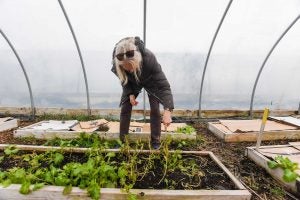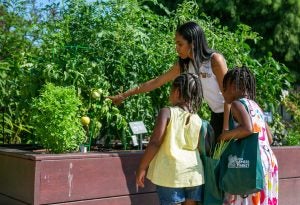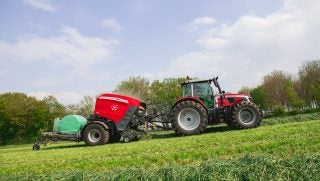Last year, the U.S. Department of Agriculture’s Urban Agriculture and Innovation Production (UAIP) office supported 52 urban agriculture projects across the United States. This equated to a total of $14.2 million dollars funneled to agriculture programs in underserved communities; communities whose access to nutritious food, green spaces, and agricultural literacy are limited.
In the summer of 2023, the USDA announced that they had funded less than half the applicants for 2023 — awarding 25 programs $7.4 million. Upon further research on the UAIP website’s Urban Agriculture Innovative Production Grant Projects, just above their displayed map of projects, I downloaded the Urban Agriculture Innovative Project Grants 2020-2023 Excel file and counted the amount of alleged recipients and their awards.
Thirty-one had been listed, however, their award amount for these fundamentally influential community projects are all still labeled “TBD.”
Are all 31 projects selected for funding? Or will only 25 receive the $7.4 million, as announced by the USDA? What is holding the government entity back from timely announcing the awards each applicant will receive to the general public for their understanding?
This initiative itself dates back to 2020. Supported through sanctioned funds of the American Rescue Plan Act, the objective of the funding is to help sustain current urban agriculture projects or activate ones across the nation. Projects that apply for sustainable money to continue their missions are called planning projects, and projects that desire to begin their ventures are called implementation projects. (For more information on these terms and their designations, please see the previous column on the UAIP Grants for 2022.)
Folks who are either planning or implementing for the future of their urban agriculture programs must apply and meet rigorous criteria in order to receive funding. Funding to various projects has ranged from $100,000 to $400,000 to grow and seed projects whose mission is to provide agriculture knowledge and experiences to urban areas across our nation.

In the last two years, we have seen the amount of projects and funding rise as a result of the funding from the American Rescue Plan Act. In 2020, at the start of these funds being disseminated to applicants, 10 planning projects and 11 implementation projects were awarded $4.75 million to urban agriculture projects in 13 states on the west and east coasts of our country. Last year, 18 planning projects and 34 implementation projects received $14.2 million in funding in 27 states, diversifying the USDA’s bandwidth of influence to more and more areas in need of agricultural literacy and experiences. Today, the number of projects decreased to half of last year’s awardees.
As stated in the USDA’s July 18 news release, 25 “planning and implementation projects” had been selected. There is no specific breakdown of which are “planning” and which are “implementation” besides a new criteria added to the release that had not been previously.
“These grants build on $40 million in projects funded since 2020 and are part of USDA’s broad support of urban agriculture,” it said. “Funding limits only allowed USDA to select the top scoring 10% of the applications reviewed. This year, USDA received more than 300 applications, twice last year’s applications.”
It’s excellent that the USDA received more applications. However, wouldn’t that prompt the government agency to procure and disseminate more funding as a result of seeing how much gumption and excitement urban agriculture projects had?
As our country continues to diversify and urbanization reins over our farmland, wouldn’t we want to be ahead of the curve, the leader of innovation, the voice in spaces that are quickly forgetting our country’s agrarian roots and fund more urban agriculture projects?
I hope we can inspire our next generation living in urban spaces to innovate food production to help feed the growing world, or be a part of slowing down urbanization.
At the beginning of December, I sat on a Zoom call with our high school agriculture program’s advisory committee. For those who just stumbled upon my columns here at AGDAILY, I am currently an agriculture educator in South Sacramento, California. Each Agriculture Education Program and FFA chapter in the nation is required to have some sort of advisory committee to provide wisdom and approve the budget of our agriculture programs — assuring that our mission and spending is germane to our local agriculture community in South Sacramento. For those who are unaware, South Sacramento is a very urban/suburban area of Northern California. Our students live in apartment complexes and small suburban communities. Our area is 93 percent low income, and our students represent more than 70 cultures; more than half of their families have immigrated from another country to our area.
On the advisory committee, one of our members is a land agent for our local Natural Resources and Conservation Services as it relates to preserving farmland for local growers and producers.
During the call, our department chair asked each of our advisory committee members this question: “What do you wish for our students to know about what’s currently happening in our local agriculture community?”
Our advisor committee member from NRCS raised her virtual hand and unmuted herself, sharing something that still hits me.
She said, “Each day, I fight to ensure that our agricultural land is not developed on. It’s a hard battle, but someone has got to do it. My hope is that our students at Florin [High School] understand that the land we grow our food on is important and that they can be a part of ensuring the future of agriculture is preserved.”

Why not work with what we have then? Residential is one pressure point we can’t get rid of in our area, especially with our high transient population. However, we can inject South Sacramento and thousands of cities like it at a young age with the idea that land is alive, it is precious, and it can be gone very quickly. We can preserve it while also ensuring that we have a way to balance food production within our urban communities.
My challenge to the USDA, its UAIP office, and even the NRCS is to invest more in urban agriculture. We can solve many health problems within our underserved communities, we can funnel urban students into careers related and adjacent to agriculture, but we can also slow the process of urbanization if we help urban communities to make the purpose of farmland. To share that, farmland is crucial to our survival and not stagnant, it is a part of our culture — it is crucial to our futures.
We can’t do that unless we invest more in agriculture literacy, agriculture nutrition programs, agriculture scholarships, and others to ensure that our urban communities are not only supported in urban agriculture projects but mindful of agriculture that lives and breathes around them in our agrarian communities that still exist.
Bre Holbert is a past National FFA President and studied agriculture science and education at California State-Chico. “Two ears to listen is better than one mouth to speak. Two ears allow us to affirm more people, rather than letting our mouth loose to damage people’s story by speaking on behalf of others.”



